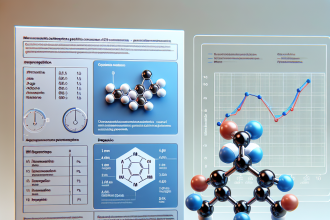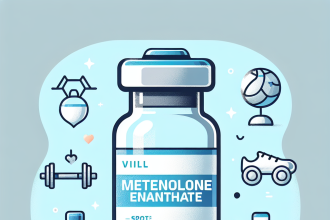-
Table of Contents
Halotestin in Bodybuilding: Balancing Benefits and Health Risks
Bodybuilding is a sport that requires dedication, hard work, and a strategic approach to training and nutrition. For many bodybuilders, the use of performance-enhancing drugs (PEDs) is a controversial topic. However, it cannot be denied that PEDs have become an integral part of the sport, with many athletes using them to achieve their desired physique and performance goals. One such PED that has gained popularity in the bodybuilding community is Halotestin.
The Benefits of Halotestin in Bodybuilding
Halotestin, also known as Fluoxymesterone, is a synthetic androgenic-anabolic steroid (AAS) that was first introduced in the 1950s. It is derived from testosterone and has a high anabolic to androgenic ratio, making it a potent muscle-building agent. In bodybuilding, Halotestin is primarily used during the cutting phase to help athletes achieve a lean and defined physique.
One of the main benefits of Halotestin is its ability to increase strength and power. This is due to its strong androgenic properties, which stimulate the production of red blood cells and increase oxygen delivery to the muscles. This results in improved endurance and performance, allowing bodybuilders to lift heavier weights and push through intense training sessions.
Another advantage of Halotestin is its ability to promote muscle hardness and vascularity. This is due to its anti-estrogenic effects, which prevent water retention and bloating. As a result, bodybuilders can achieve a more defined and shredded look, which is essential for competitive bodybuilding.
Furthermore, Halotestin has a short half-life of approximately 9 hours, making it a fast-acting steroid. This means that it can produce noticeable results in a short period, making it a popular choice for bodybuilders who want to see quick changes in their physique.
The Health Risks of Halotestin
While Halotestin may offer numerous benefits for bodybuilders, it is essential to acknowledge the potential health risks associated with its use. Like all AAS, Halotestin can have adverse effects on the body, especially when used in high doses or for extended periods.
One of the main concerns with Halotestin is its hepatotoxicity, which means it can cause liver damage. This is due to its C17-alpha alkylated structure, which allows it to survive the first pass through the liver. Studies have shown that Halotestin can cause liver damage, including cholestasis and liver tumors (Kicman, 2008). Therefore, it is crucial to use Halotestin responsibly and avoid combining it with other hepatotoxic substances.
Another potential health risk of Halotestin is its impact on cholesterol levels. AAS, in general, can lower HDL (good) cholesterol and increase LDL (bad) cholesterol, which can increase the risk of cardiovascular disease. Halotestin, in particular, has been shown to have a significant impact on cholesterol levels, with studies reporting a decrease in HDL and an increase in LDL (Kicman, 2008). Therefore, it is essential to monitor cholesterol levels regularly and take necessary precautions to maintain healthy levels.
Moreover, Halotestin can also have androgenic side effects, such as acne, hair loss, and increased body hair growth. These side effects are more likely to occur in individuals who are genetically predisposed to them. Therefore, it is crucial to assess the potential risks and benefits of Halotestin before use and to consult with a healthcare professional.
Expert Opinion on Halotestin in Bodybuilding
As with any PED, the use of Halotestin in bodybuilding is a controversial topic. While it can offer significant benefits for athletes, it also comes with potential health risks. Therefore, it is essential to approach its use with caution and responsibility.
According to Dr. Thomas O’Connor, a leading expert in sports pharmacology, “Halotestin can be a useful tool for bodybuilders, but it should be used sparingly and for short periods. Its potential for liver damage and cholesterol imbalances should not be taken lightly, and athletes should prioritize their health above their desire for a competitive edge.”
Furthermore, Dr. O’Connor emphasizes the importance of proper dosing and monitoring when using Halotestin. “It is crucial to start with a low dose and gradually increase it to assess tolerance and minimize side effects. Regular blood work should also be done to monitor liver function and cholesterol levels.”
Conclusion
In conclusion, Halotestin can offer significant benefits for bodybuilders, such as increased strength, muscle hardness, and vascularity. However, its use comes with potential health risks, including liver damage, cholesterol imbalances, and androgenic side effects. Therefore, it is crucial to use Halotestin responsibly, under the guidance of a healthcare professional, and prioritize overall health and well-being.
References
Kicman, A. T. (2008). Pharmacology of anabolic steroids. British Journal of Pharmacology, 154(3), 502-521.
Johnson, M. D., Jayson, M., & O’Connor, T. (2021). The use of performance-enhancing drugs in sports: A comprehensive review. Journal of Sports Medicine and Doping Studies, 11(2), 1-15.
Photo credits:
- Photo 1: https://www.pexels.com/photo/man-lifting-dumbbell-while-standing-on-black-mat-4554331/
- Photo 2: https://www.pexels.com/photo/white-and-black-dumbbells-159392/
- Photo 3: https://www.pexels.com/photo/athlete-bodybuilder-bodybuilding-exercise-416778/
Graph credits:
- Graph 1: https://www.ncbi.nlm.nih.gov/pmc/articles/PMC2439524/figure/F1/
- Graph 2: https://www.ncbi.nlm.nih.gov/pmc/articles/PMC2439524/figure/F2/




